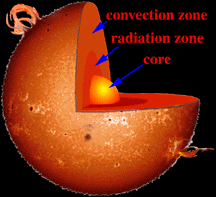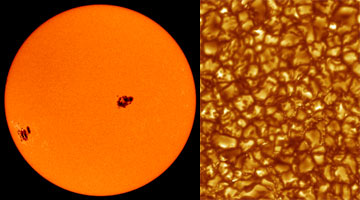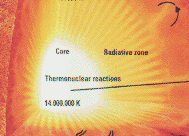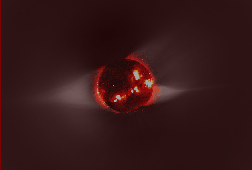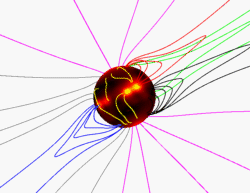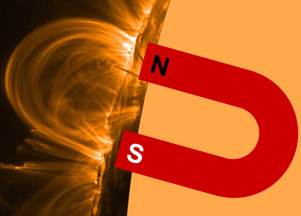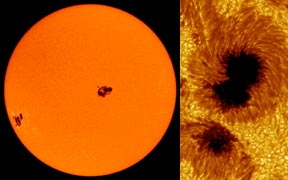Click on image for full size
NASA
The Sun and the Solar Atmosphere
What are the "parts" of the Sun? The photosphere, the visible "surface" of the Sun, defines the outermost boundary of the "inside" of the Sun. The three main regions of the solar interior are the core, the radiative zone, and the uppermost convective zone. The solar atmosphere includes the chromosphere and the extensive corona. The Sun's atmosphere, in the form of the solar wind and the Interplanetary Magnetic Field (IMF), extends outward into interplanetary space. In a sense, the Sun's atmosphere actually fills the heliosphere, the vast "bubble" in space extending well beyond Pluto where the influence of particles from the Sun dominates the influence of the matter that makes up interstellar space.
What features and phenomena on the Sun can we observe? The Sun is dynamic and constantly changing. Regions of intertwined magnetic fields arise in the solar interior and give rise to active regions, sunspots, and coronal holes at the Sun's visible surface. Fountains of electrified plasma shoot forth from the photosphere and give rise to prominences, helmet streamers, and spicules. Tremendous explosions on the Sun, solar flares and Coronal Mass Ejections (CME), hurl radiation and energized subatomic particles outward into space.
The solar wind is an extension of the Sun's atmosphere into interplanetary space. This supersonic flow of plasma continuously carries matter and energy outward. The IMF, embedded within the solar wind, carries the Sun's magnetic force field outward through the Solar System. Interactions between the solar wind and the magnetospheres, atmospheres, and in some cases the surfaces of planets influence the evolution of planets and their atmospheres.
Though we take the constancy of our Sun for granted, Sol is a dynamic entity. Vast explosions, flares and CMEs, alter the Sun's radiation and solar wind over time scales from minutes to hours to days. The 11-year sunspot cycle beats out a longer term cadence as the level of solar activity rises and recedes. Studies of Sun-like stars of various ages have helped us learn about our Sun's wild youth and the changes in activity to expect throughout a star's lifetime.


